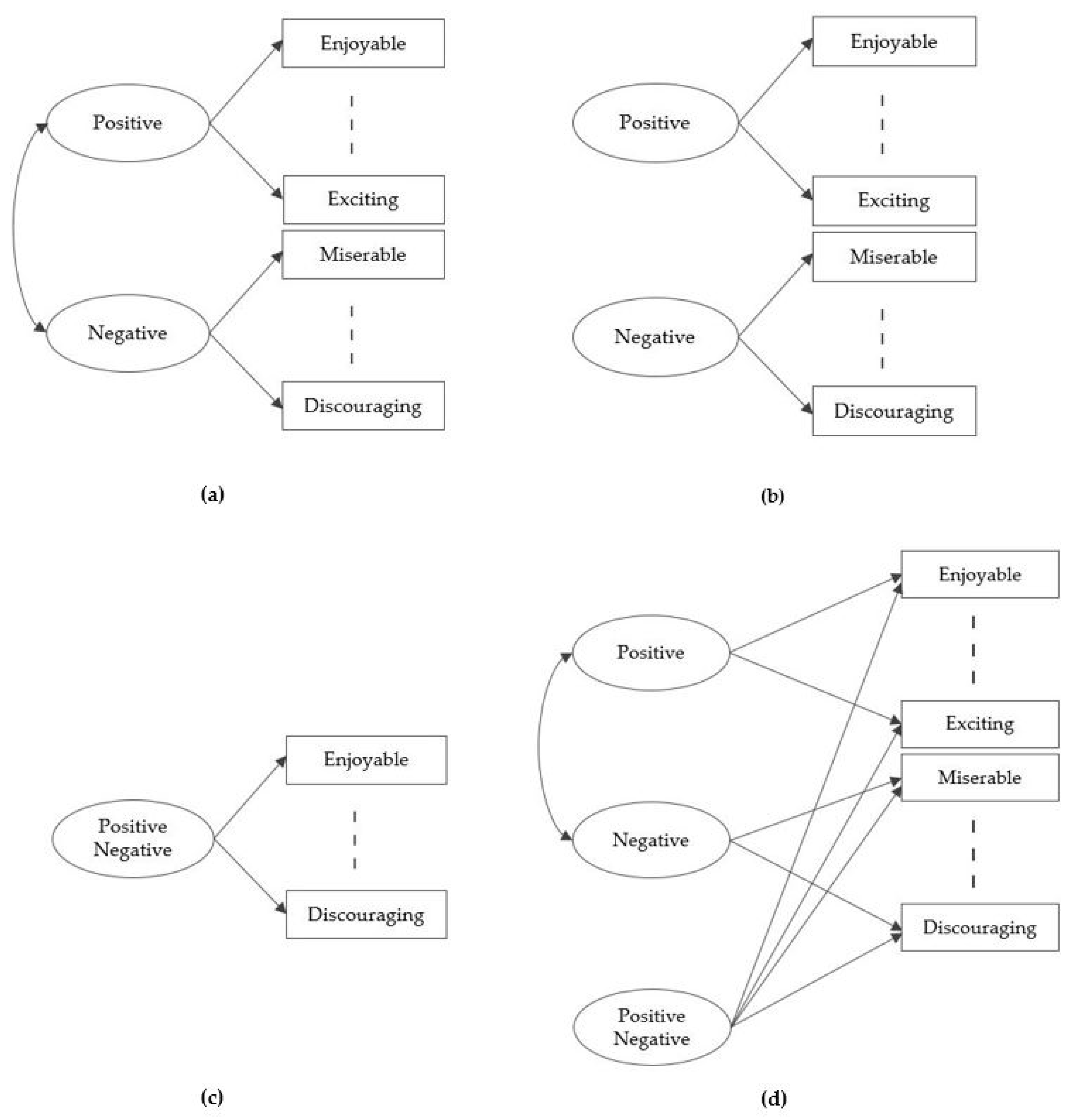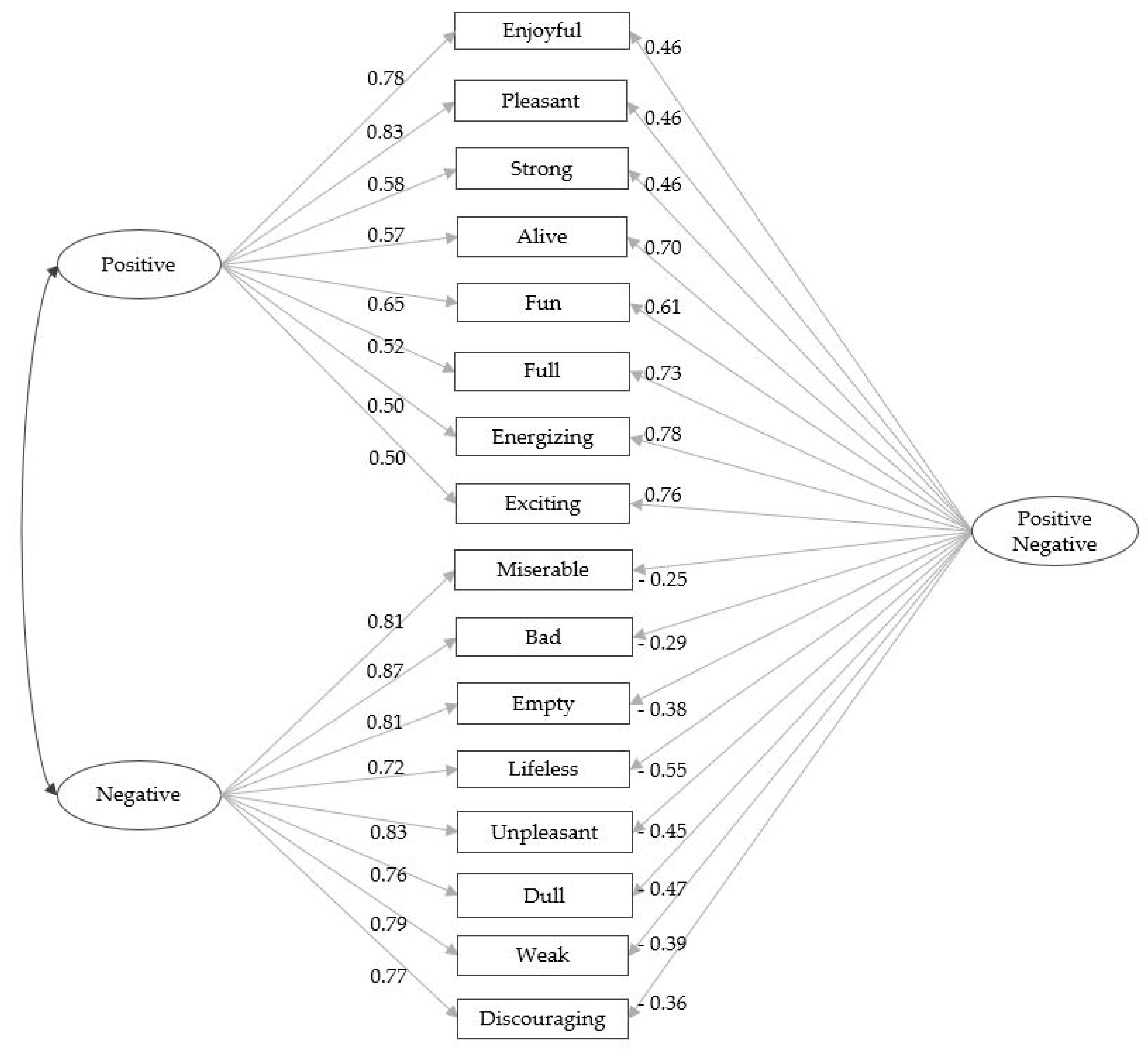Turkish Adaptation of the Positive–Negative Relationship Quality (PN-RQ) Scale: A Reliability and Validity Study
Abstract
:1. Introduction
2. Study 1
2.1. Methods
2.1.1. Participants
2.1.2. Instruments
2.1.3. Procedure
2.2. Results
2.2.1. Structure Validity and Reliability
2.2.2. Correlation of PN-RQ Scales
3. Study 2
3.1. Methods
3.1.1. Participants
3.1.2. Instruments
3.1.3. Procedure
3.2. Results
3.2.1. Structure Validity and Reliability
3.2.2. Confirmatory Factor Analysis
3.2.3. Correlation of PN-RQ Scales
3.2.4. Bivariate Distinctiveness
3.2.5. Short Version CFA
4. Discussion
5. Conclusions
Author Contributions
Funding
Conflicts of Interest
Appendix A. Turkish Version of the PN-RQ Scale
| Hiç Doğru Değil | Çok az Doğru | Biraz Doğru | Oldukça Doğru | Çok Doğru | Bütünüyle Doğru | |
|---|---|---|---|---|---|---|
| Zevkli | O | O | O | O | O | O |
| Keyifli | O | O | O | O | O | O |
| Güçlü | O | O | O | O | O | O |
| Canlı | O | O | O | O | O | O |
| Eğlenceli * | O | O | O | O | O | O |
| Dopdolu * | O | O | O | O | O | O |
| Enerji verici * | O | O | O | O | O | O |
| Heyecan verici * | O | O | O | O | O | O |
| Hiç Doğru Değil | Çok az Doğru | Biraz Doğru | Oldukça Doğru | Çok Doğru | Bütünüyle Doğru | |
|---|---|---|---|---|---|---|
| Berbat * | O | O | O | O | O | O |
| Kötü * | O | O | O | O | O | O |
| Boş * | O | O | O | O | O | O |
| Cansız | O | O | O | O | O | O |
| Tatsız * | O | O | O | O | O | O |
| Sıkıcı | O | O | O | O | O | O |
| Zayıf | O | O | O | O | O | O |
| Heves kırıcı | O | O | O | O | O | O |
References
- Fowers, B.; Laurenceau, J.; Penfield, R.; Cohen, L.; Lang, S.; Owenz, M.; Pasipanodya, E. Enhancing relationship quality measurement: The development of the Relationship Flourishing Scale. J. Fam. Psychol. 2016, 30, 997–1007. [Google Scholar] [CrossRef] [PubMed]
- Hassebrauck, M.; Fehr, B. Dimensions of Relationship Quality. Pers. Relatsh. 2002, 9, 253–270. [Google Scholar] [CrossRef]
- Fincham, F.D.; Rogge, R. Understanding Relationship Quality: Theoretical Challenges and New Tools for Assessment. J. Fam. Theory Rev. 2010, 2, 227–242. [Google Scholar] [CrossRef]
- Fincham, F.; Beach, S. Relationship Satisfaction. In The Cambridge Handbook of Personal Relationships; Vangelisti, A., Perlman, D., Eds.; Cambridge University Press: Cambridge, UK, 2012; pp. 579–594. [Google Scholar]
- Reynolds, J.; Houlston, C.; Coleman, L. Understanding Relationship Quality; OnePlusOne: London, UK, 2014; Available online: http://www.oneplusone.org.uk/wpcontent/uploads/2014/02/Understanding-Relationship-Quality (accessed on 16 February 2018).
- Brown, S.L.; Manning, W.D.; Payne, K.K. Relationship Quality Among Cohabiting Versus Married Couples. J. Fam. Issues 2017, 38, 1730–1753. [Google Scholar] [CrossRef] [PubMed]
- Basharpoor, S.; Sheykholeslami, A. The Relation of Marital Adjustment and Family Functions with Quality of Life in Women. Eur. J. Psychol. 2015, 11, 432–441. [Google Scholar] [CrossRef] [PubMed]
- Proulx, C.; Helms, H.; Buehler, C. Marital Quality and Personal Well-Being: A Meta-Analysis. J. Marriage Fam. 2007, 69, 576–593. [Google Scholar] [CrossRef]
- Robles, T.; Slatcher, R.; Trombello, J.; McGinn, M. Marital quality and health: A meta-analytic review. Psychol. Bull. 2014, 140, 140–187. [Google Scholar] [CrossRef] [PubMed]
- Braithwaite, S.; Delevi, R.; Fincham, F. Romantic relationships and the physical and mental health of college students. Pers. Relatsh. 2010, 17, 1–12. [Google Scholar] [CrossRef]
- Cummings, E.M.; Davies, P.T. Marital Conflict and Children: An Emotional Security Perspective; Guilford Press: New York, NY, USA, 2011. [Google Scholar]
- Fletcher, G.J.O.; Simpson, J.A.; Thomas, G. The Measurement of Perceived Relationship Quality Components: A Confirmatory Factor Analytic Approach. Pers. Soc. Psychol. Bull. 2000, 26, 340–354. [Google Scholar] [CrossRef]
- Locke, H.J.; Wallace, K.M. Short marital-adjustment and prediction tests: Their reliability and validity. Marriage Fam. Living 1959, 21, 251–255. [Google Scholar] [CrossRef]
- Spanier, G. Measuring Dyadic Adjustment: New Scales for Assessing the Quality of Marriage and Similar Dyads. J. Marriage Fam. 1976, 38, 15–28. [Google Scholar] [CrossRef]
- Norton, R. Measuring Marital Quality: A Critical Look at the Dependent Variable. J. Marriage Fam. 1983, 45, 141–151. [Google Scholar] [CrossRef]
- Schumm, W.R.; Nichols, C.W.; Schectman, K.L.; Grigsby, C.C. Characteristics of responses to the Kansas Marital Satisfaction Scale by a sample of 84 married mothers. Psychol. Rep. 1983, 53, 567–572. [Google Scholar] [CrossRef]
- Rust, J.; Golombok, S. The GRISS: A psychometric instrument for the assessment of sexual dysfunction. Arch. Sex. Behav. 1986, 15, 157–165. [Google Scholar] [CrossRef] [PubMed]
- Hendrick, S.S.; Dicke, A.; Hendrick, C. The Relationship Assessment Scale. J. Soc. Pers. Relatsh. 1998, 15, 137–142. [Google Scholar] [CrossRef]
- Chonody, J.M.; Gabb, J.; Killian, M.; Dunk-West, P. Measuring Relationship Quality in an International Study: Exploratory and Confirmatory Factor Validity. Res. Soc. Work Pract. 2018, 28, 920–930. [Google Scholar] [CrossRef] [PubMed]
- Farooqi, S. The Construct of Relationship Quality. J. Relatsh. Res. 2014, 5, 1–11. [Google Scholar] [CrossRef]
- Rogge, R.; Fincham, F.; Crasta, D.; Maniaci, M. Positive and Negative Evaluation of Relationships: Development and Validation of the Positive–Negative Relationship Quality (PN-RQ) scale. Psychol. Assess. 2017, 29, 1028–1043. [Google Scholar] [CrossRef] [PubMed]
- Fışıloğlu, H.; Demir, A. Brief Report. Applicability of the Dyadic Adjustment Scale for Measurement of Marital Quality with Turkish Couples. Eur. J. Psychol. Assess. 2000, 16, 214–218. [Google Scholar] [CrossRef]
- Kline, R. Principles and Practice of Structural Equation Modeling; Guilford Publications: New York, NY, USA, 2010. [Google Scholar]
- Browne, M.; Cudeck, R. Alternative Ways of Assessing Model Fit. Sociol. Methods Res. 1992, 21, 230–258. [Google Scholar] [CrossRef]
- Thompson, B. Exploratory and Confirmatory Factor Analysis; American Psychological Association: Washington, DC, USA, 2004. [Google Scholar]
- Chen, F.F.; Zhang, Z. Bifactor Models in Psychometric Test Development. In The Wiley Handbook of Psychometric Testing; Irwing, P., Booth, T., Hughes, D.J., Eds.; Wiley Blackwell: West Sussex, UK, 2018; pp. 325–345. [Google Scholar]


| Items | Mean (SD) | Factor | Items | Mean (SD) | Factor |
|---|---|---|---|---|---|
| Enjoyable | 4.88 (1.12) | 0.81 | Miserable | 1.31 (0.66) | 0.66 |
| Pleasant | 5.02 (1.08) | 0.86 | Bad | 1.51 (0.85) | 0.78 |
| Strong | 4.98 (1.30) | 0.62 | Empty | 1.61 (1.03) | 0.79 |
| Alive | 4.65 (1.28) | 0.88 | Lifeless | 1.77 (1.07) | 0.76 |
| Fun | 4.91 (1.19) | 0.85 | Unpleasant | 1.58 (0.95) | 0.84 |
| Full | 4.48 (1.35) | 0.80 | Dull | 1.72 (1.04) | 0.72 |
| Energizing | 4.67 (1.34) | 0.83 | Weak | 1.49 (0.91) | 0.70 |
| Exciting | 4.77 ( 1.41) | 0.81 | Discouraging | 1.82 (1.22) | 0.70 |
| Items | Mean (SD) | Factor | Items | Mean (SD) | Factor |
|---|---|---|---|---|---|
| Enjoyable | 4.34 (1.31) | 0.86 | Miserable | 1.83 (1.26) | 0.91 |
| Pleasant | 4.26 (1.30) | 0.88 | Bad | 1.83 ( 1.26) | 0.98 |
| Strong | 4.55 (1.37) | 0.57 | Empty | 1.86 (1.31) | 0.91 |
| Alive | 3.89 (1.41) | 0.90 | Lifeless | 2.22 (1.39) | 0.78 |
| Fun | 3.92 (1.42) | 0.91 | Unpleasant | 2.00 (1.37) | 0.91 |
| Full | 3.75 (1.41) | 0.90 | Dull | 2.10 ( 1.32) | 0.79 |
| Energizing | 3.69 (1.46) | 0.91 | Weak | 1.96 (1.38) | 0.84 |
| Exciting | 3.60 ( 1.45) | 0.93 | Discouraging | 2.20 (1.45) | 0.84 |
| Models | χ2/df | RMSEA a | CFI b | NFI c |
|---|---|---|---|---|
| Model 1: Correlated two-factor | 7.08 | 0.12 | 0.98 | 0.97 |
| Model 2: Orthogonal two-factor | 9.52 | 0.13 | 0.97 | 0.96 |
| Model 3: One-factor | 31.66 | 0.37 | 0.88 | 0.88 |
| Model 4: Bi-factor | 4.70 | 0.09 | 0.99 | 0.98 |
| Satisfied n = 165 | Dissatisfied n = 177 | Indifferent n = 55 | Ambivalent n = 56 |
|---|---|---|---|
| 112.66 (16.24) | 74.45 (22.42) | 98.48 (12.17) | 99.28 (16.37) |
© 2019 by the authors. Licensee MDPI, Basel, Switzerland. This article is an open access article distributed under the terms and conditions of the Creative Commons Attribution (CC BY) license (http://creativecommons.org/licenses/by/4.0/).
Share and Cite
Araz, A.; Güngör, D.; Aşçı, E. Turkish Adaptation of the Positive–Negative Relationship Quality (PN-RQ) Scale: A Reliability and Validity Study. Behav. Sci. 2019, 9, 100. https://doi.org/10.3390/bs9090100
Araz A, Güngör D, Aşçı E. Turkish Adaptation of the Positive–Negative Relationship Quality (PN-RQ) Scale: A Reliability and Validity Study. Behavioral Sciences. 2019; 9(9):100. https://doi.org/10.3390/bs9090100
Chicago/Turabian StyleAraz, Arzu, Duygu Güngör, and Eda Aşçı. 2019. "Turkish Adaptation of the Positive–Negative Relationship Quality (PN-RQ) Scale: A Reliability and Validity Study" Behavioral Sciences 9, no. 9: 100. https://doi.org/10.3390/bs9090100
APA StyleAraz, A., Güngör, D., & Aşçı, E. (2019). Turkish Adaptation of the Positive–Negative Relationship Quality (PN-RQ) Scale: A Reliability and Validity Study. Behavioral Sciences, 9(9), 100. https://doi.org/10.3390/bs9090100





